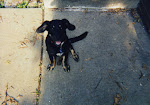We are just outside of Heraklion, Crete in a tiny town called Eskopi - other than having a cool Airbnb in the countryside, the highlight of this place is the local grocer who gives you shots of raki (the local grape hooch).
 |
| Jen and Janine at Knossos |
One of the reasons we are here is it's proximity to Knossos - ruins of the ancient (2000 BC) Minoan culture - supposedly one of the first "empires" of Europe. Janine, Jen, and I head there early this morning while Tyler, Fiona, and Dan did a Father's Day trip to a local beach with caves.
Minos is the legendary king who had Daedylus built the labyrinth and then put the half-bull / half-man Minotaur (Minos = king, Taur = variation of bull) in the labyrinth to slay Athenian sacrifices - 7 boys and 7 girls every 7 years. Later the Athenian prince Theseus would carry some string into the maze, kill the monster, escape with Minos's daughter - there's a lot going on here with a cross-over episode with Daedylus and his kid Icarus.
 |
| Me with some Labrys (double-headed axes) |
But the coolest piece of etymological data the I learned, that Labyrinth developed from the Labrys - the double headed axe that was the symbol of the Palace at Knossos. The palace itself was massive for it's time with hundreds of rooms and 5 levels - an easy place to get lost. From these two concepts, the double-axe logo and the complexity of the palace, it developed into the word Labyrinth - palace of the double axe. In addition, the Minoan people held bulls sacred and had a passage ritual of grabbing the horns and flipping over the back of the bull - many were injured and killed in this process. These ideas eventually merged into the myth of sacrificing young people to the Minotaur and the Labryinth of Crete.
 |
| The "Labyrinth" of Knossos |
We head out tomorrow for the legendary blue and white houses of Santorini.


No comments:
Post a Comment